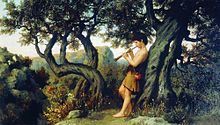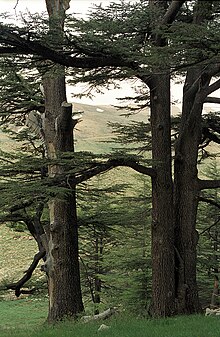The dance (poem)
The round dance ( Arabic المواكب al-Mawākib ) is a 1919 poem by the Lebanese-American writer Khalil Gibran . It is the longest and most important of his few verse poems and at the same time one of the last works that he published in Arabic .
Structure of the seal and background
The dance consists of a total of 203 lines and 18 two-part chants. In terms of content, it is a dialogue between the complaint, which often slips into the cynical and nihilistic, about the human weaknesses revealed in society on the one hand and the sensual response of a voice of nature in mystical thinking on the other. Due to the repetitive, almost monotonous character of the speech of the nature-loving voice, it is formally given a refrain-like function. Thematically, the poem anticipates many thoughts that Gibran was to elaborate four years later in his main work The Prophet . It is already part of a more mature phase of his thinking.
Text example

|
في الناس مصنوع إذا جبروا الخير |
Man only does good when he is destined to do so; |
Analysis and interpretation
The symbolist and transcendentalist poem is strongly influenced by the writings of Ralph Waldo Emerson , through whom Gibran familiarized himself with, among other things, Neoplatonist and Buddhist ideas, but also by those of Henry David Thoreau , especially his book Walden . This can already be seen in the first stanza, whose concept of humans as "machines" and "herd animals" could almost exactly come from the essays by Emerson. “Fate” - in Gibran dahr , the destructive time much-quoted in ancient Arabic poetry - means here the constraints imposed on people by society and accepted only too readily by which they become servants and slaves.
In contrast to these models, however, Gibran uses a decidedly suggestive and fragmentary, but also deliberately sublime and classicistic language. It also remains unclear whether the two voices of the poem belong to the same figure, a godlike fool ( Madman ) similar to the protagonist of the first English-language publication Gibran, published a year earlier, or whether they can be assigned to two different men of different ages, an experienced one Wise men and an innocent youth.
reception
The poem is in particular also due to its setting in the form of the song Give me the flute (أعطني الناي) became very popular. The music comes from Najīb Hankasch (1904–1979), who, with the help of Gabriel Migliori, published it in Brazil in the 1930s, initially without much success. After he returned to Lebanon in 1947, he introduced the song to the singer Fairuz , who interpreted it in 1964 in a version edited by the Rahbani brothers and made it known throughout the Arab-speaking world. It contains excerpts mainly from the epilogue of the poem.
Individual evidence
- ↑ Nadeem Naimy: The Mind and Thought of Khalil Gibran . In: Journal of Arabic Literature 5, 1974, p. 56.
- ^ Translation from Khalil Gibran: The Music. The dance. Transferred by Ursula Assaf-Nowak and S. Yussuf Assaf . Walter Verlag, Zurich 1998, p. 40 f.
- ↑ Ahmad Y. Majdoubeh: Gibran's "the Procession" in the context transcendentalist . In: Arabica 49/4, 2002, pp. 477-493.
- ^ Nadeem Naimy: The Mind and Thought of Khalil Gibran , pp. 61 f.
- ↑ See in particular the English translation of the poem by George Khayralla: The Procession . The Wisdom Library, New York 1958.
- ↑ Ali J. Racy: The Lebanese Diaspora in Brazil and the US ( Memento of the original from February 28, 2014 in the Internet Archive ) Info: The archive link was inserted automatically and has not yet been checked. Please check the original and archive link according to the instructions and then remove this notice. , Afropop Worldwide, 2013.

